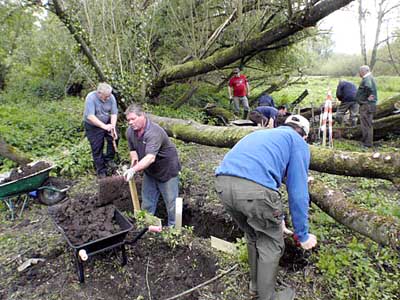The Environment Agency has joined forces with Thames Water, the University of Reading, the Farley Estate and Arborleigh Angling Club to make the £290,000 Arborfield scheme a reality, following many years of planning.
The 200-metre bypass will provide enhanced spawning and nursery grounds for a wide range of species including sea trout, barbel and eel; and 25km of free fish passage from the River Thames to Basingstoke under the right flow conditions. It will help the River Loddon meet ‘good ecological status’ required by the Water Framework Directive (WFD) and be used as a case study for other WFD-led projects. It will help other species such as kingfishers, water voles and herons.
Dominic Martyn, an Environment Agency fisheries officer and project leader, said: “This is a unique and exciting partnership project. The channel will be passable to all fish species and create 80m of new spawning ground while making use of existing natural woodland features. It’s been hard work due to the complexities of the site, but thanks to the great team work by all of the partners construction has commenced.”
Around 2.5ha of nationally important wet land habitats will be restored, the equivalent of more than two Wembley-sized football pitches, and the project also has benefits for managing water levels on this stretch of the River Loddon at the Farley Estate.
 |
| Aborleigh AC members help with the dig |
The scheme has been backed by the Loddon Fisheries and Conservation Consultative, Wokingham Borough Council and the Swallowfield Parish Flood Resilience Committee. Volunteers from Arborleigh Angling Club, Thames Water and the Environment Agency have put in more than 50 man days of volunteer time.
In 2007 the project partners agreed to table options relating to their respective problems. These included improved site access, reduced risk of collapse of upstream banks, better fish passage, wildlife and habitats improvements and new angling opportunities.
Phase one of the scheme finished in July 2010, which involved Thames Water lowering and repairing four out of five weir structures to reduce upstream water levels and bank breaching. Water was backed up 4.5km upstream and chub have been observed spawning on the new restored shallow gravel habitats now that weirs have been lowered.
 |
| The fish pass under construction |
The weirs are also a barrier to fish movement, impounding and restricting habitats upstream, and had contributed to water breaching banks next to the A327 road. Previously high water levels hindered safe access for the area’s angling clubs, Thames Water staff and other visitors.
The University play a key role in logistics and by allowing the re-use of fertile soil from the bypass to be used as a resource. This, along with other plans to use excavated materials, means that all material from the works will be used to benefit wildlife and habitats and none taken off site.
Nigel Frankland, the University’s Head of Estates Management, said: ”The University of Reading is pleased to have been able to work so closely with the other partners in the project to reach such a good fisheries solution, and at the same time hopefully benefiting the wet woodland and other wildlife habitats in the area.”










